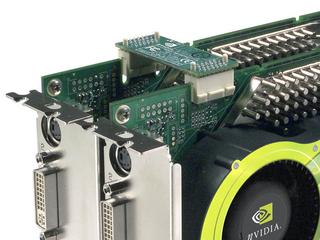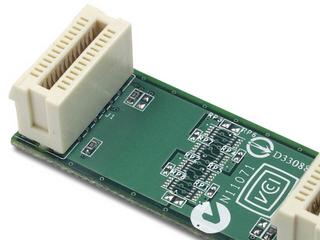![]()
PresenTech
PCI Express and SLI Technology
http://www.hardwareanalysis.com/content/article/1728/

With the launch of Intel's 900-series chipsets and the recent return of SLI
to video cards, PCI Express has finally arrived on the PC enthusiast scene
in a big way. PCI Express-enabled motherboards are going to start becoming
more and more common, and with the new bus's increasing ubiquity will come
the inevitable confusion that accompanies the rise of any new technology, especially
one as complex and feature-rich as PCI Express.
Today, NVIDIA is announcing is new SLI technology for GeForce 6800 graphics
cards with PCI Express. The "golden finger" protruding from the top
of the GeForce 6800GT is, in fact, an SLI connector. Place a pair of GeForce
6800 cards into a special motherboard with a pair of PCI Express X16 expansion
slots, and this connector will help hook the two cards together for tandem
operation.
SLI technology began a year after 1996 with the introduction of the Voodooo2
Graphics card. Two cards could be combined using a type of SLI (Scan Line Interleave)
configuration. The entrance of PCI-Express and NVIDIA re-introducing the SLI
concept now called Scalable Link Interface will take over the Graphic Card
market
Voodoo2 SLI utilized a ribbon cable connecting the two Voodoo2 cards internally
and a pass through VGA cable externally to distribute the analog signal. However,
NVIDIA's implementation is all done drawing on digital technology.
 A SLI, Scalable Link Interface connects the two PCI-Express cards, named the
MIO port, a high-speed digital interconnect which connects to a connector on
top of both cards allowing them to communicate to each other and allocate the
workload which is accelerated by dynamic load-balancing algorithms. NVIDIA
has not released what makes their SLI implementation tick exactly (besides
the fact that both hardware and software contribute to making SLI work), most
of the dynamic load balancing between the two graphics processors is handled
in software and thus SLI needs driver support, which are as of yet unreleased,
to work. Exact performance figures are not yet available, but NVIDIA says that
prospective performance numbers should show a performance increase closer to
90% over that of a single graphics card.
A SLI, Scalable Link Interface connects the two PCI-Express cards, named the
MIO port, a high-speed digital interconnect which connects to a connector on
top of both cards allowing them to communicate to each other and allocate the
workload which is accelerated by dynamic load-balancing algorithms. NVIDIA
has not released what makes their SLI implementation tick exactly (besides
the fact that both hardware and software contribute to making SLI work), most
of the dynamic load balancing between the two graphics processors is handled
in software and thus SLI needs driver support, which are as of yet unreleased,
to work. Exact performance figures are not yet available, but NVIDIA says that
prospective performance numbers should show a performance increase closer to
90% over that of a single graphics card.
You need a motherboard that includes two PCI-Express x16 slots which will also
use the more costly Intel Xeon processors. Secondly you'll need two identical,
same brand and type, PCI-E GeForce 6800 graphics cards. This extreme hardware
and software comes with an extreme price starting at the PCI-Express cards
which come up to $500 US for one. Regardless of the price the capabilities
are endless. More power (90% increase compared to one graphics card), larger
bandwidth (60X more bandwidth), higher resolution (1600 x 1200 easily), and
workstation capabilities (four monitors connected to one CPU) are just some
of the features offered by SLI technology using PCI Express.
I believe that soon this card would become standard due to the demand for better
graphic performance and the fact that the latest version of Windows operating
system is going to be in three dimensions. NVIDA’s SLI technology along
with the PCI-express graphics cards have propelled them to No.1 in terms of “The
best 3D performance available” and have again revolutionize 3D graphics
once you’re willing to pay the price.
Michael Phillips (99710)
INFS428 Database Systems Design and Development
Please contact cucmichaelphillips@hotmail.com
with your questions, comments, and suggestions.
Copyright © 99710 Webdev™ Inc. All rights reserved.